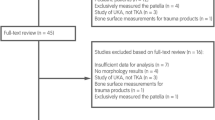Abstract
There is an ongoing debate whether gender differences in the dimensions of the knee should influence the design of TKA components. We hypothesized that not only gender but also the patient’s morphotype determined the shape of the distal femur and proximal tibia and that this factor should be taken into account when designing gender-specific TKA implants. We reviewed all 1000 European white patients undergoing TKA between April 2003 and June 2007 and stratified each into one of three groups based on their anatomic constitution: endomorph, ectomorph, or mesomorph. Of the 250 smallest knees, 98% were female, whereas 81% of the 250 largest knees were male. In the group with intermediate-sized knees, female knees were narrower than male knees. Patients with smaller knees (predominantly female) demonstrated large variability between narrow and wide mediolateral dimensions irrespective of gender. The same was true for larger knees (predominantly male). This variability within gender could partially be explained by morphotypic variation. Patients with short and wide morphotype (endomorph) had, irrespective of gender, wider knees, whereas patients with long and narrow morphotype (ectomorph) had narrower knees. The shape of the knee is therefore not only dependent on gender, but also on the morphotype of the patient.
Level of Evidence: Level I, diagnostic study. See Guidelines for Authors for a complete description of levels of evidence.







Similar content being viewed by others
References
Barrett WP. The need for gender-specific prostheses in TKA: does size make a difference? Orthopedics. 2006;29:S53–S55.
Battista RA, Pivarnik JM, Dummer GM, Sauer N, Malina RM. Comparison of physical characteristics and performances among female college rowers. J Sport Sci. 2007;25:651–657.
Bindelglass DF, Dorr LD. Current concepts review: symmetry versus asymmetry in the design of total knee femoral components—an unresolved controversy. J Arthroplasty. 1998;13:939–944.
Bulbulian R. The influence of somatotype on anthropometric prediction of body composition in young women. Med Sci Sports Exerc. 1984;16:389–397.
Charlton WP, St John TA, Ciccotti MG, Harrison N, Schweitzer M. Differences in femoral notch anatomy between men and women: a magnetic resonance imaging study. Am J Sports Med. 2002;30:329–333.
Chin KR, Dalury DF, Zurakowski D, Scott RD. Intraoperative measurements of male and female distal femurs during primary total knee arthroplasty. J Knee Surg. 2002;15:213–217.
Conley S, Rosenberg A, Crowninshield R. The female knee: anatomic variations. J Am Acad Orthop Surg. 2007;15:S31–S36.
Gender-specific knee replacements: a technology overview. J Am Acad Orthop Surg. 2008;16:63–67.
Greene K. Gender-specific design in total knee arthroplasty. J Arthroplasty. 2007;22(Suppl. 3):27–31.
Griffin FM, Math K, Scuderi GR, Insall JN, Poilvache PL. Anatomy of the epicondyles of the distal femur: MRI analysis of normal knees. J Arthroplasty. 2000;15:354–359.
Hawker GA, Wright JG, Coyte PC, Williams JI, Harvey B, Glazier R, Badley EM. Differences between men and women in the rate of use of hip and knee arthroplasty. N Engl J Med. 2000;342:1016–1022.
Heath BH, Carter JE. A comparison of somatotype methods. Am J Phys Anthropol. 1966;24:87–99.
Heath BH, Carter JE. A modified somatotype method. Am J Phys Anthropol. 1967;27:57–74.
Hitt K, Shurman JR, Greene K, McCarthy J, Moskal J, Hoeman M, Mont MA. Anthropometric measurements of the human knee: correlation to the sizing of current knee arthroplasty systems. J Bone Joint Surg Am. 2003;85(Suppl 4):115–122.
Ho WP, Cheng CK, Liau JJ. Morphometrical measurements of resected surface of femurs in Chinese knees: correlation to the sizing of current femoral implants. Knee. 2006;13:12–14.
Kawashima K, Kat K, Miyazaki M. Body size and somatotype characteristics of male golfers in Japan. J Sports Med Phys Fitness. 2003;43:334–341.
MacDonald SJ, Charron KD, Bourne RD, Naudie DD, McCalden RW, Rorabeck CH. The John Insall Award: Gender-specific total knee replacement. Prospectively collected clinical outcomes. Clin Orthop Relat Res. 2008;466:2612–2616.
Mahfouz MR, Merkl BC, Fatah EE, Booth R, Argenson JN. Automatic methods for characterization of sexual dimorphism of adult femora: distal femur. Comput Methods Biomech Biomed Engin. 2007;10:447–456.
Merchant AC, Arendt EA, Dye SF, Fredericson M, Grelsamer RP, Leadbetter WB, Post WR, Teitge RA. The female knee. Anatomic variations and the female-specific total knee design. Clin Orthop Relat Res. 2008;466:3059–3065.
Murshed KA, Cicekcibasi AE, Karabacakoglu A, Seker M, Ziylan T. Distal femoral morphometry: a gender and bilateral comparative study using magnetic resonance imaging. Surg Radiol Anat. 2005;27:108–112.
Poilvache PL, Insall JN, Scuderi GR, Font-Rodriguez DE. Rotational landmarks and sizing of the distal femur in total knee arthroplasty. Clin Orthop Relat Res. 1996;331:35–46.
Sheldon WH. The somatotype, the morphophenotype, and the morphogenotype. Cold Spring Harb Symp Quant Biol. 1950;15:373–382.
Slaughter MH, Lohman TG. Relationship of body composition to somatotype. Am J Phys Anthropol. 1976;44:237–244.
Acknowledgments
We thank Steffen Fieuws and his coworkers from the Biostatistical Centre of the School of Public Health of the Catholic University Leuven for the statistical analysis.
Author information
Authors and Affiliations
Corresponding author
Additional information
Each author certifies that he or she has no commercial associations (eg, consultancies, stock ownership, equity interest, patent/licensing arrangements, etc) that might pose a conflict of interest in connection with the submitted article.
Each author certifies that his or her institution has approved the human protocol for this investigation and that all investigations were conducted in conformity with ethical principles of research.
About this article
Cite this article
Bellemans, J., Carpentier, K., Vandenneucker, H. et al. The John Insall Award: Both Morphotype and Gender Influence the Shape of the Knee in Patients Undergoing TKA. Clin Orthop Relat Res 468, 29–36 (2010). https://doi.org/10.1007/s11999-009-1016-2
Received:
Accepted:
Published:
Issue Date:
DOI: https://doi.org/10.1007/s11999-009-1016-2




